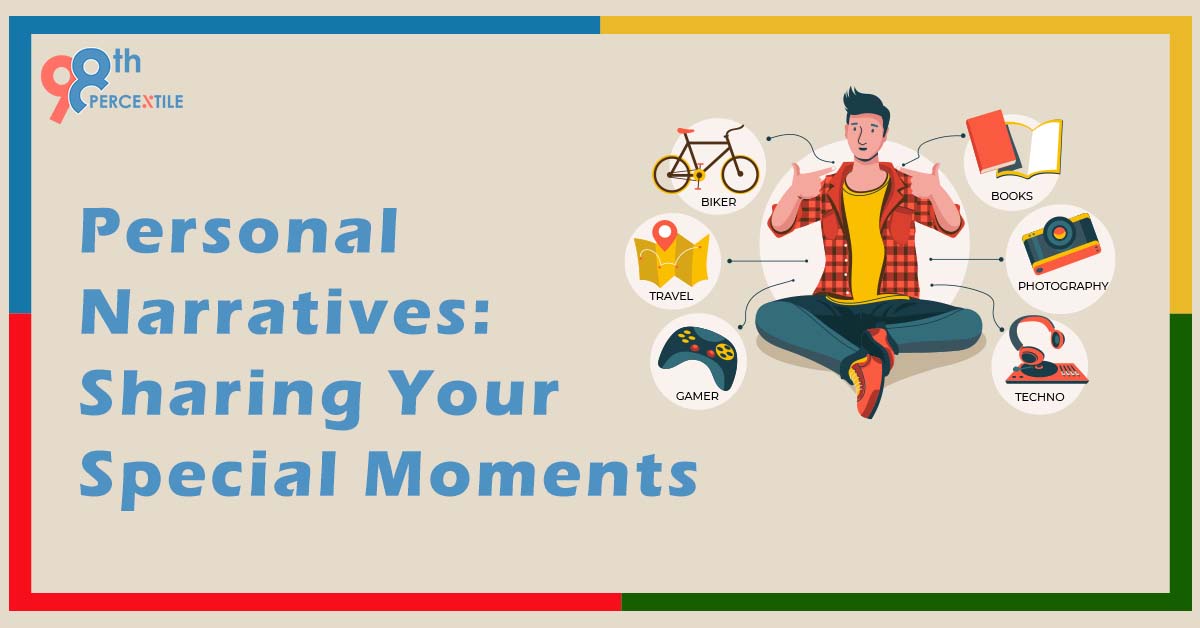A personal narrative is a form of writing that tells a story from the author's own life or personal experiences. It is a way for the writer to share a significant event, moment, or series of events while also reflecting on their thoughts, feelings, and insights related to the experience. Personal narratives are characterized by their first-person point of view, which allows the author to intimately connect with the reader and convey their unique perspective.
Narrative writing holds immense benefits for young students, shaping their language proficiency, cognitive capacities, and overall communication aptitude. Here's an exploration of how this form of writing aids students, especially when introduced early:
Language Development: Through narrative writing, students are prompted to expand their vocabulary. As they vividly depict characters, settings, and events, they learn to select words with precision, effectively conveying their ideas. This process bolsters their linguistic prowess, instilling a passion for language and storytelling.
Creativity and Imagination: Narrative writing serves as a fertile ground for nurturing creativity and imagination. Students are spurred to invent characters, settings, and plots, fostering an environment for the exploration of creativity and honing their storytelling skills. This instills a sense of wonder, fostering a lifelong affection for both reading and writing.
Critical Thinking: The creation of narratives demands critical thinking from students. They are tasked with making decisions regarding character motivations, plot intricacies, and causal relationships. This process cultivates problem-solving abilities and enhances their capacity to analyze complex scenarios.
Empathy and Perspective-Taking: Through the creation of characters and immersing themselves in their roles, students develop empathy and the capacity to consider diverse viewpoints. This enriches their social and emotional intelligence, enabling them to relate to others more effectively.
Self-Expression: Narrative writing offers a secure avenue for self-expression. It grants students the space to delve into their thoughts, emotions, and experiences through their writing. This proves especially advantageous for young children who may not yet possess the vocabulary or emotional acumen to articulate them verbally.
Reflective Practice: Articulating personal experiences and reflections through writing equips students with self-awareness and the ability to glean insights from their encounters. This proves to be a valuable life skill, fostering personal growth and informed decision-making. According to Nicole Iwuala, a writer from College, Our life unfolds like a narrative, encompassing both the highs and lows, friendships and conflicts, as well as unexpected twists and turns. Every aspect of your journey as a high school student holds significance when it comes to your college application. Your identity matters, as do your accomplishments. While having a diligent and scholarly disposition may be reflected in your grades, you are more than just a GPA. You possess a deep understanding of yourself, but college admission offices lack that insight, making it crucial to seize various opportunities to convey your uniqueness during the college application process. Your
application should be viewed from an outsider's perspective, allowing you to mold your story into the narrative you wish to present.
Narrative writing entails the art of storytelling or recounting events, employing a specific toolkit of strategies to ensnare and engross the reader. These are some pivotal techniques and counsel for crafting compelling narratives:
Certainly, let's delve into each of these narrative techniques with suitable examples:

Character Development:
Craft multi-dimensional characters: In J.R.R. Tolkien's "The Lord of the Rings," Gollum is a multi-dimensional character. He possesses a dark side driven by the One Ring's power but also has moments of vulnerability and inner struggle.
Chart character evolution: In Charles Dickens's "Great Expectations," Pip undergoes a significant transformation from a humble orphan to a complex character with both admirable and flawed qualities.
Setting Description:
Enlist sensory elements: In Harper Lee's "To Kill a Mockingbird," the town of Maycomb is vividly described, incorporating sensory details.
Immerse readers: In J.K. Rowling's "Harry Potter" series, Hogwarts School of Witchcraft and Wizardry is brought to life with detailed descriptions of its enchanted surroundings, from the moving staircases to the Great Hall feasts.
Plot Structure:
Narrative structure: In William Shakespeare's "Romeo and Juliet," the narrative structure is evident. The exposition introduces the feuding families, leading to rising action as Romeo and Juliet's love blossoms, climaxing in their tragic deaths, and concluding with the resolution of the feud.
Foster tension: In George Orwell's "1984," tension mounts as the protagonist Winston becomes entangled in a rebellion against a dystopian regime, culminating in a suspenseful climax when he is apprehended by the Thought Police.
Conflict and Resolution:
Introduce conflicts: In J.D. Salinger's "The Catcher in the Rye," the internal conflict of the protagonist, Holden Caulfield, as he grapples with his own alienation and disillusionment, drives the narrative forward.
Gratifying resolution: In Khaled Hosseini's "The Kite Runner," the primary conflict involving betrayal and redemption is resolved when the protagonist, Amir, seeks to make amends with his childhood friend and half-brother, Hassan.
Point of View (POV):
Narrative perspective: In F. Scott Fitzgerald's "The Great Gatsby," the narrative is presented through the first-person point of view of Nick Carraway, allowing readers to gain insight into his personal experiences and perceptions.
Consistency: In Jane Austen's "Pride and Prejudice," the third-person limited point of view is consistently maintained, providing insight into the thoughts and feelings of the characters while maintaining narrative distance.
These techniques, when skillfully employed, enhance the richness and depth of a narrative, creating a more engaging and immersive reading experience. They allow readers to connect with characters, settings, and themes on a deeper level, making the story more compelling and memorable. Try 98thPercentile now by booking a free trial session here.

 Students/Staff
Students/Staff Parents
Parents ElevatEd
ElevatEd













